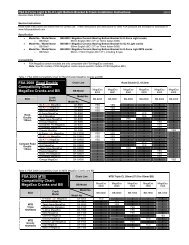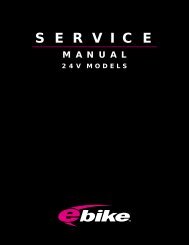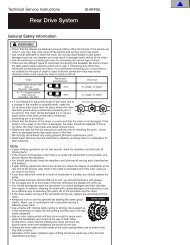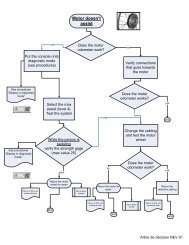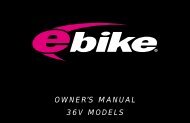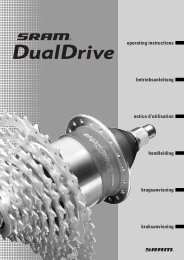Katima to Cape Ride - Electric bikes & folding bikes
Katima to Cape Ride - Electric bikes & folding bikes
Katima to Cape Ride - Electric bikes & folding bikes
- No tags were found...
Create successful ePaper yourself
Turn your PDF publications into a flip-book with our unique Google optimized e-Paper software.
eZeebike<strong>Katima</strong> <strong>to</strong> <strong>Cape</strong> <strong>Ride</strong>By Rupert NanniWhen I first mentioned theidea <strong>to</strong> James Swift, theezeebike distribu<strong>to</strong>r inSouth Africa, I got thesame reaction as frommost people. “You’re mad!”But he didn’t s<strong>to</strong>p there.He spoke <strong>to</strong> Wai WonChing, the head ofezee<strong>bikes</strong> in Shanghai, and<strong>to</strong>gether they said “You’remad, but let’s do it. We’vegot just the bike for thejob”. Ching even said he’dride with me and so itstarted.The idea behind it was <strong>to</strong>show off electric <strong>bikes</strong> <strong>to</strong>the public and prove thatezee<strong>bikes</strong> are one of themost reliable, low costforms of transport. If the<strong>bikes</strong> could go throughwhat I had planned forthem, then they wouldn’tbreak a sweat potteringaround <strong>to</strong>wn. I put <strong>to</strong>gethera route that would be long,hot, wet, dusty, bumpy andincluded tar and gravelsections. Distances variedeach day depending on theterrain and I tried <strong>to</strong>alternate hard days withrecovery days. In practicethis didn’t always work,and in fact the shortest dayof the whole trip turned out<strong>to</strong> be one of the mostdifficult.The <strong>bikes</strong> we were going <strong>to</strong>use were the eZee Torqs, ahybrid bike with 28 inchwheels best suited <strong>to</strong> thevaried terrain. A 37V 10Ahlithium polymer batterypowers a brushless electricmo<strong>to</strong>r in the front hub, andconnecting batteries inparallel would give us therange needed <strong>to</strong> do thelong distances. We alsoadded a Cycle Analystcomputer <strong>to</strong> each bike <strong>to</strong>moni<strong>to</strong>r closely thecondition of the batteries,and changed the standard250rpm mo<strong>to</strong>r <strong>to</strong> a 300rpmversion. This would allowus <strong>to</strong> travel at higherspeeds, but at the expenseof some <strong>to</strong>rque. Thestandard throttle wasreplaced with ezee’s cruisecontrol dial <strong>to</strong> prevent wristfatigue. All this adds up <strong>to</strong>a hefty piece of machinery,especially when carryingup <strong>to</strong> four litres of water,food, <strong>to</strong>ols etc. A backupcar was therefore used <strong>to</strong>carry all our overnightequipment and <strong>to</strong> supplyfresh batteries, which weusually needed once ortwice a day.We set off from <strong>Katima</strong>Mulilo on the banks of theStarting in the northeastern Namibian <strong>to</strong>wn of<strong>Katima</strong> Mulilo, the routecrossed the Caprivi Stripbefore turning south atRundu, and heading<strong>to</strong>wards Windhoek. Herethe tar ends as youtraverse and thendescend from the centralplateau in<strong>to</strong> the NamibDesert.Hightemperatures, dust andgravel roads characterisethis section. PassingSossusvlei, the riderswent <strong>to</strong> Rosh Pinah andfollowed the OrangeRiver, before crossingin<strong>to</strong> South Africa. Astraight run south throughGaries and Clanwillliamsaw them finish in<strong>Cape</strong>Town, 3000km and14 days later afteraveraging more than200km per day.
Spreetshoogte Pass at sunriseZambezi River in the early hours of the morning, with 312km ahead of us. This area is relatively flat so a 300km+ day wasone of the goals we had set ourselves and it was completed it in just under ten hours with two battery changes. The firstcouple of days through the Caprivi Strip were all long tar hauls with little traffic but lots of wildlife. During onethunders<strong>to</strong>rm we rode in<strong>to</strong> a group of elephants who were as surprised <strong>to</strong> see us as we were <strong>to</strong> see them. Luckily theyscattered in<strong>to</strong> the bush.Riding a bicycle at speed gives you a new appreciation for wind resistance and we had lots of time <strong>to</strong> test differenttheories. On certain days, we would find that increasing speed from 32km/hr <strong>to</strong> 38km/hr would double batteryconsumption (with the same amount of leg effort) for a mere 6km/hr increase. Headwinds which plagued us most of theway <strong>to</strong> <strong>Cape</strong> Town were the biggest challenge, mentally and physically. There were the odd tailwind days though, andone of these allowed us <strong>to</strong> do 202km at an average of 38km/hr!As we neared Windhoek the traffic increased and the final 100km in<strong>to</strong> the Namibian capital was very stressful. We werewitnessing Africa’s in<strong>to</strong>lerance for cycling first hand. On several occasions we were driven off the road, some people evenstabbing their fingers in<strong>to</strong> their temples in the universal sign for madness.The second leg of the tripwas the dirt road sectionsthrough the Namib Desert. Imust confess I was a littlenervous about this. I’d donesome off road testing overChristmas, but never with abike this loaded, and neverthrough loose gravel andsand. After a couple ofkilometres though, I started<strong>to</strong> get the feel of the bike,and used carefully, it was a lot of fun. We had on the standard Schwalbe Marathon Plus tyres which are designed fortrekking. Although narrow and lacking any knobblies, they performed extremely well and finished the trip with only apuncture in Chings front wheel.The Namib turned out <strong>to</strong> be a highlight of the whole ride. It was extremely hot but provided you kept moving and drinking,you were fine. In fact riding wasn’t hot but s<strong>to</strong>pping was. The gravel roads varied from very good <strong>to</strong> pure mountain bike
Still miles <strong>to</strong> go south wes<strong>to</strong>f Windhoekterri<strong>to</strong>ry, and cycling downSpreetshoogte Pass atsunrise must surely rate asone of the worlds bestrides. Once on the flatlands below, theshimmering road stretchedstraight <strong>to</strong> the horizon, andwhen you got there, it did itagain. Probably the biggestchallenge were sand trapsin river beds which aregenerally <strong>to</strong>o small <strong>to</strong>bother building a bridgeover. In the Namib they’redry except immediatelyafter the rains, and hittingthese at speed made forsome heart s<strong>to</strong>ppingmoments. I found that withthe correct use of power <strong>to</strong>the front wheel and a highcadence at the back, youcould power through in fulltwo wheel drive.Corrugations were the worst though. Occasionally they would cover the full width of theroad and you got rattled <strong>to</strong> a halt. Amazingly, the bike showed no signs of any damage.Again wildlife was plentiful, even in the desert, and we saw springbok, gemsbok, kudu,steenbok, zebra, jackal, scrub hare, kori bustard, ground squirrels, cobra and ostrich.The Orange River forms the border between Namibia and South Africa, and cuts throughthe Richterveld and Ais Ais National Parks. It’s a mountainous desert and the barren hills oneither side of the river act as reflec<strong>to</strong>rs, building up a fearsome heat during the day. Werecorded 42 degrees, but it got hotter than this when we turned away from the river andDayDistance(km)AvgSpeed(km/hr)Time(hr:min)Ascent(m)AmpHoursWh/kmWatthrsKm/battery131232.59:5322043.95161962220029.36:4133535.96.5131950326630.38:4543568.89.6247138420238.35:2249056.610.12039345260318:3573165.49.6241437616924.87:0779034.17.4126042713722.36:3930327.57.51031468145168:0877634.18.8126636920822.69:20161055.710.220373510168354:53447429.61560341114621.86:5489031.17.811553712247298:34152459.48.82201411322432.37:1280337.86.51429561422930.87:05215454.59198437The NamibrandNature ReserveAvg 28.3 8.3 41.8TOTAL 2913 105:13 11508 646.8 23786Average speed on tar - 32km/hr. Average speed on gravel - 21.5km/hr.
ControlsWeightBatteryChargerControllerRated powerStandard Model TorqTri-modal: throttle power-ondemand(or eZee Assist Fac<strong>to</strong>rDial), pedelec, pedal-onlyBicycle 22 kgLi Battery 3.1 kgTotal 25.1 kg37V 10 Ah Lithium with batterymanagement circuit. Batterycan be removed for or leftlocked securely on the bikeAu<strong>to</strong>matic Smart charger,maximum charge time 5 hoursPWM microprocessor and LEDself-diagnostic system. Overloadprotection 20 amps, Lowvoltage protection 31.5V250 Watts nominal poweroutputclimbed over a spur. At one point, the slight tail breeze wasblowing at the same speed as our movement, leaving us in stillair. Chings bike cut out when the controller overheated so Isuggested we walk <strong>to</strong> the <strong>to</strong>p <strong>to</strong> let it cool down, but he washaving none of it. He thought that his cunning little commuterwas above walking up a hill, so he grabbed my water bottle andsquirted his controller. A minute later he was off, shouting “Usethe powaaaaa. <strong>Electric</strong> powaaaaa”.People often ask how much help you get from one of these<strong>bikes</strong> and that depends on how much effort you put in. I havecome from a mountain biking background and I tend <strong>to</strong> pedalthe ezeebike the same as I do a normal bike. The only differenceRated currentRange5 AmpsUp <strong>to</strong> 60kmFrame Road bike All alloy 6061 T4 T6Tyres Schwalbe marathon 700C x 45 (27 x 1.75” ) with K Shieldpuncture resistantRim Weinmann (Rigida) CNC alloytwin wallGears Shimano Nexave and Sora 8speed with RF thumb shift.Some easy, some not so easyis that with electrical assistance you go faster. Climbing hills is where the big gainsare made and these can be done at double the speed that I’m used <strong>to</strong>.Back in South Africa and on the tar once again, we had our minds now on <strong>Cape</strong>Town, but were in for a rude surprise. We had the first real hills of the trip. Lots ofthem, and <strong>to</strong>gether with the heat, burning sun, traffic and headwind made the247km <strong>to</strong> Garies one of the <strong>to</strong>ughest days of all. The last 60km felt like 200.On reaching <strong>Cape</strong> Town we did a de<strong>to</strong>ur <strong>to</strong> Bloubergstrand <strong>to</strong> jump on the beach.We’d done it! The finish at Canal Walk was a big surprise with a good crowd <strong>to</strong>welcome us home. The ride had obviously generated a lot of interest in South Africa.The Torqs proved <strong>to</strong> be incredibly reliable. They had ridden through severalthunders<strong>to</strong>rms, been subject <strong>to</strong> almost impossible heat, run at maximum power forhours on end, almost rattled <strong>to</strong> death on corrugations and even in Chings casecrashed a couple of times, yet they ran <strong>to</strong> the finish as smoothly and quietly as theyhad started. All we did was oil the chains and lower the tyre pressure for the dirt. Wehad ventured in<strong>to</strong> true 4x4 terri<strong>to</strong>ry and covered distances that would be impossibleon a normal bike.Wai Won Ching, the founder ofeZee<strong>bikes</strong> has “Treat the earthwell” as his company mot<strong>to</strong>. He iscommitted <strong>to</strong> low carbon transportand has ridden the Silk Routethrough China <strong>to</strong> promote the useof electric <strong>bikes</strong>.Looking at the stats, my lowest Wh/km figure was on the first day. Although thiswas the longest, I knew that the overnight s<strong>to</strong>p had limited genera<strong>to</strong>r power, so I’dused a lot of leg effort <strong>to</strong> keep some batteries for the next day. The average of 42kmper battery across varied terrain was very good, considering we were not riding foreconomy. Back at home with a single battery and no luggage, I averaged between60 and 70km when ridden economically. And the best part of all, adding a 20% lossthrough the charger, the “fuel” bill for my bike was R15.98 at Eskom rates of56c/kWh. The rates vary, but even if you double that, it surely makes electric <strong>bikes</strong>the most efficient way of getting around!For more information visit www.ezeebike.co.zaRupert Nanni, a keen environmentalist, trail guideand cyclist has travelled extensively throughAfrica by bicycle. He currently lives inJohannesburg where he uses an electric bike <strong>to</strong>get around.



